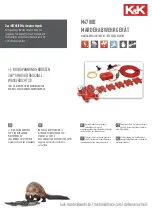
82
SECURITY CODE - LEVEL C
Available:
only if CODE.B is 0 or On.
Upper display: 0, 1, On.
Lower display: CODE.C
Range:
Use
▲
and
▼
keys to input the security codes. 0 means no security code (the
parameters related to level A, level B and level C are always unlocked). 1 means no
security code (all parameters related to level C are always locked). A number from
501 to 1000 is the code for level C protection.
NOTE: When complete, return dipswitches to operating mode. Once the security codes are
selected, their values cannot be displayed again but the display shows On. If the codes are
forgotten, new values should be chosen, using the above procedure. It is recommended that
a code unlocks Levels A, B, and C. Unlocking Level B unlocks Levels B and A. unlocking A
only unlocks A. When the SECUR functions are accessed in Group 1, the levels that are
locked will be followed by a decimal point. E.g. A.B.C. indicates that all levels are locked.
12.
PID C
ONTROLLER
D
EFINITIONS
Proportional Band - The value shown on the controller is expressed as a percentage of span. The
smaller the number is the tighter the control and greater the response of the controller for a certain
error. However, selecting a value that is too small tends to make the process unstable (cycling) while
too large a value results in a loose response.
Integral Time - Aids the controller in returning the process to set point. This response is only
concerned with the amount of error that exists between the actual pressure and set point, and how
long (time) the error has existed. The integral response ONLY functions when an error exists.
Reducing the value of the integral setting (Ti) increases the amount of the integral response. A
numerical setting that is too large (40) results in process which will not return to set point, while a
value which is too small (0.1) will result in an unstable process.
Derivative Time - Aids the controller in responding to fast changes in the process. This response is
concerned only with the rate of error taking place. The more QUICKLY the actual pressure begins
varying from set point, the more quickly this function forces the controller to respond. Note that
derivative only functions when the error is changing and will not correct for large errors which are
stable. Increasing the numerical value of Td increases the amount of derivative response, and
decreasing the value decreases the response. While a derivative value, which is too small, will result
in sluggish response to quickly changing errors, a value, which is too large, will quickly cause an
unstable process as the controller attempts to correct for every little variation. This is especially true
in extrusion processes.
Integral Preload - Assists the controller in recovering from a system upset. To properly adjust,
observe the % of power out during steady state control. The % shown in the lower display is the
value that should be programmed into Ip.
Summary of Contents for ATC770
Page 19: ...ATC770 Microprocessor Based Pressure Process Controller 19 Fig 2 ATC770 Outline Drawing...
Page 23: ......
Page 30: ...30 Fig 6 Remote Set Point Jumper Location Board E...
Page 84: ...NOTES...
Page 85: ...NOTES...
Page 86: ...NOTES...
Page 88: ...DYNISCO INSTRUMENTS 38 FORGE PARKWAY FRANKLIN MA 02038 ATTN MARKETING DEPT Place Stamp Here...







































